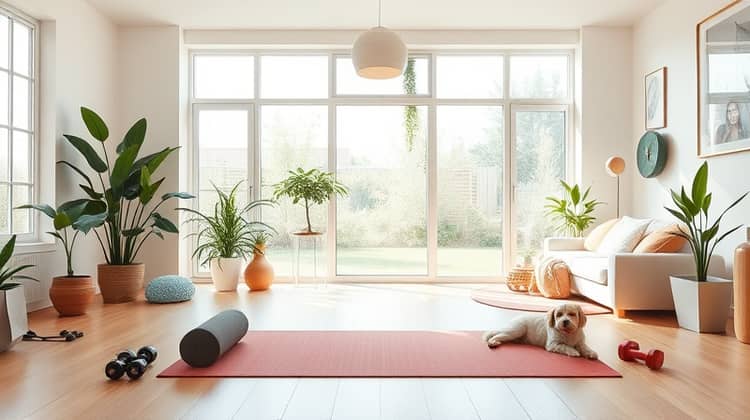In today's fast-paced world, many of us find it challenging to prioritize our physical health. A home fitness routine can provide a convenient and effective way to stay active, leading to improved well-being and quality of life. However, starting a fitness routine from scratch can feel overwhelming, especially with so much conflicting information available online.
The key to embarking on your fitness journey is to establish a clear plan. This article aims to guide you through seven essential steps that will help you create a sustainable home fitness routine, ensuring you can achieve your health and fitness goals effectively.
Whether you’re looking to lose weight, build muscle, or simply maintain a healthy lifestyle, these foundational steps will provide you with the structure and motivation needed to succeed. Let's delve into each step to kickstart your home fitness journey.
1. Define Your Goals

Setting clear, measurable goals is the first step in establishing a successful home fitness routine. Without specific goals, it's easy to become discouraged or lose focus.
Take some time to think about what you want to achieve with your fitness routine. Whether it’s weight loss, muscle gain, increased endurance, or simply staying active, having a clear target will help guide your efforts.
- Identify short-term and long-term fitness goals
- Make your goals specific and measurable
- Consider including a mix of various fitness components
- Set realistic timelines for achieving your goals
- Write down your goals and keep them visible
Once you have defined your fitness goals, you will have a clearer direction for your workout routine, which will also aid in tracking your progress and staying motivated.
2. Assess Your Space

Before you begin with your home fitness routine, it’s essential to evaluate the space available for your workouts. Assessing your space will help you understand what workouts can be performed and how to optimize your environment for fitness.
- Ensure adequate space for movement
- Consider ventilation and lighting
- Identify areas with minimal distractions
- Make adjustments for family members or pets
Creating a designated workout area can help you mentally separate your fitness time from other activities. A consistent space for exercise can also help reinforce the habit.
3. Plan Your Routine

Once you have your goals and space evaluated, it’s time to create a workout plan tailored to your objectives. This plan will act as your guide for what exercises to do and when to do them.
- Incorporate cardio, strength, and flexibility exercises
- Schedule specific workout days and times
- Start with a manageable routine and gradually increase intensity
- Consider including rest days in your plan
Having a well-structured plan in place makes it easier to remain consistent and dedicated to your fitness journey.
4. Get the Right Equipment

Depending on your fitness goals and the space available, you may need to invest in some basic equipment to enhance your workouts. However, you don't need to break the bank to get started.
- Dumbbells or resistance bands
- A yoga mat
- Jump rope
- A stability ball
- A reliable water bottle
Remember that you can always start with bodyweight exercises, which require no equipment at all. As you advance, you can gradually introduce more equipment to diversify your workouts.
5. Educate Yourself

Knowledge is power when it comes to fitness. Understanding the fundamentals of exercise, nutrition, and recovery will help you make informed decisions and improve your results.
Consider reading books, subscribing to fitness blogs, watching instructional videos, or even consulting with professionals for advice.
- Learn proper exercise techniques
- Understand the importance of nutrition
- Familiarize yourself with recovery practices
- Stay updated on fitness trends and research
The more you educate yourself, the better equipped you'll be to tailor your workout and nutrition plan, ensuring it remains effective and enjoyable.
6. Stay Motivated

Staying motivated throughout your fitness journey can be challenging, especially when faced with setbacks or busy schedules. It’s important to find ways to keep yourself inspired and committed.
Consider setting up an accountability system, whether it's through sharing your goals with friends or using apps that track your progress.
- Set mini-challenges for yourself
- Join online fitness communities
- Treat yourself when you reach milestones
- Use motivational quotes or visuals around your workout space
Finding joy in the process and celebrating small victories can keep your motivation high. A positive mindset plays a crucial role in achieving your fitness goals.
7. Track Your Progress

Tracking your progress is essential to understanding how far you've come and where you still need to improve. It can also provide a much-needed boost to your motivation and commitment.
Consider keeping a fitness journal or using apps to record your workouts, achievements, and adjustments.
- Log your workouts and progress regularly
- Track changes in weight or measurements
- Reflect on challenges and successes
- Adjust your goals as needed
Seeing your improvements over time will reinforce your dedication to your routine and may even inspire you to push harder to reach new levels of fitness.
Conclusion

In conclusion, starting a home fitness routine involves a clear set of steps that will guide you toward achieving your goals effectively. By defining your objectives, assessing your space, planning your routine, and equipping yourself appropriately, you are setting the groundwork for success.
It’s essential to cultivate the right mindset and stay motivated throughout your journey. Education and progress tracking will further enhance your experience, making your fitness endeavor sustainable and engaging over time.














